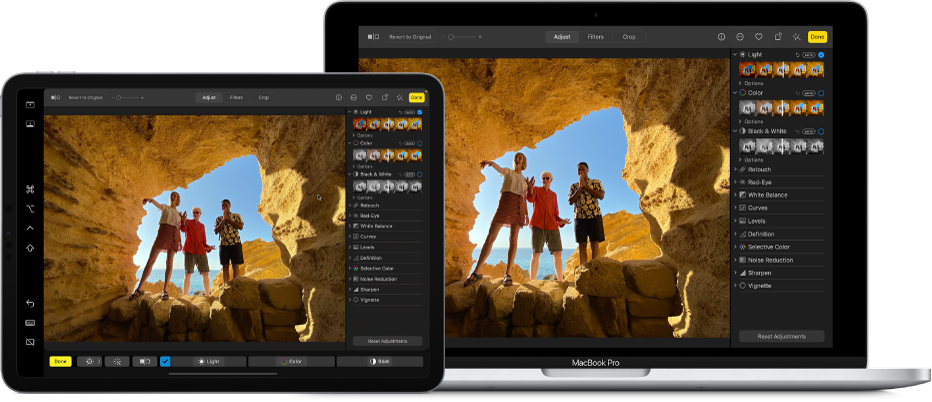
Use your iPad as a second display for your Mac
With Sidecar, you can use your iPad in landscape orientation as a second display for your Mac. Like any second display, you can extend your desktop by showing different apps or windows on your iPad, or instead make it show the same ones you see on your Mac.

Note: Sidecar is a Continuity feature. To use Continuity features, your devices must have Wi-Fi and Bluetooth turned on and meet system requirements. See the Apple Support article System requirements for Continuity on Mac, iPhone, iPad and Apple Watch.
Set up Sidecar
You don’t need to connect your iPad to your Mac with a cable to use Sidecar, but you do need to be signed in with the same Apple ID on both devices. Then follow these steps.
On your Mac, choose Apple menu

 in the sidebar. (You may need to scroll down.)
in the sidebar. (You may need to scroll down.)Click the
 pop-up menu on the right (below the name of your Mac), then choose your iPad.
pop-up menu on the right (below the name of your Mac), then choose your iPad.You can also use Control Centre to set up Sidecar. Click Control Centre
 in the menu bar, click Screen Mirroring, then choose your iPad.
in the menu bar, click Screen Mirroring, then choose your iPad.
After you set up Sidecar, the Screen Mirroring menu ![]() appears in the menu bar. You can easily change how you work with iPad from the Screen Mirroring menu at any time. For example, switch between using iPad as a mirrored or separate display, or show or hide the sidebar or Touch Bar on iPad.
appears in the menu bar. You can easily change how you work with iPad from the Screen Mirroring menu at any time. For example, switch between using iPad as a mirrored or separate display, or show or hide the sidebar or Touch Bar on iPad.
Change Sidecar options
After you set up your iPad as a second display for your Mac, you can change the options in Displays settings.
On your Mac, choose Apple menu

 in the sidebar. (You may need to scroll down.)
in the sidebar. (You may need to scroll down.)Select the name of your iPad on the right, then do one of the following:
Click the “Use as” pop-up menu, then choose whether you want to use your iPad as the main display or to mirror or extend your display.
Click the pop-up menu next to Show Sidebar and choose whether to show the sidebar on the left, the right or not at all.
Click the pop-up menu next to Show Touch Bar and choose whether to show the Touch Bar on the top, the bottom or not at all.
Turn on Enable double tap on Apple Pencil.
Use Sidecar
Do any of the following:
Move windows from Mac to iPad: Drag a window to the edge of the screen until the pointer appears on your iPad. Or while using an app, choose Window > Move to iPad.
Move windows from iPad to Mac: Drag a window to the edge of the screen until the pointer appears on your Mac. Or while using an app, choose Window > Move Window Back to Mac.
Use the sidebar on iPad: With your finger or Apple Pencil, tap icons in the sidebar to show
 or hide
or hide  the menu bar, show
the menu bar, show  or hide
or hide  the Dock, or show the onscreen keyboard
the Dock, or show the onscreen keyboard  . Or tap one or more modifier keys, such as Control
. Or tap one or more modifier keys, such as Control  , to use keyboard shortcuts.
, to use keyboard shortcuts.Use the Touch Bar on iPad: With your finger or Apple Pencil, tap any button in the Touch Bar. The buttons available vary depending on the app or task.
Use Apple Pencil on iPad: With your Apple Pencil, tap to select items such as menu commands, tickboxes or files. If your Apple Pencil supports it (and you selected the option in Displays settings), you can double-tap the lower section of your Apple Pencil to switch drawing tools in some apps. See the Apple Support article Pair Apple Pencil with your iPad.
Use gestures on iPad: Use basic gestures, such as tap, swipe, scroll and zoom, as well as gestures for entering and editing text. See the iPad User Guide.
Switch between the Mac desktop and the iPad on iPad: Swipe up from the bottom edge of your iPad with one finger to show the Home Screen. To show the iPad Dock, swipe up and pause. To show the App Switcher, swipe up and pause in the centre of the screen. To return to the Mac desktop, swipe up, then tap the Continuity icon
 .
.
When you’re ready to stop using your iPad, tap the Disconnect icon
 at the bottom of the sidebar on iPad.
at the bottom of the sidebar on iPad.You can also disconnect on your Mac by clicking the active iPad listed in the Screen Mirroring menu
 in the menu bar.
in the menu bar.